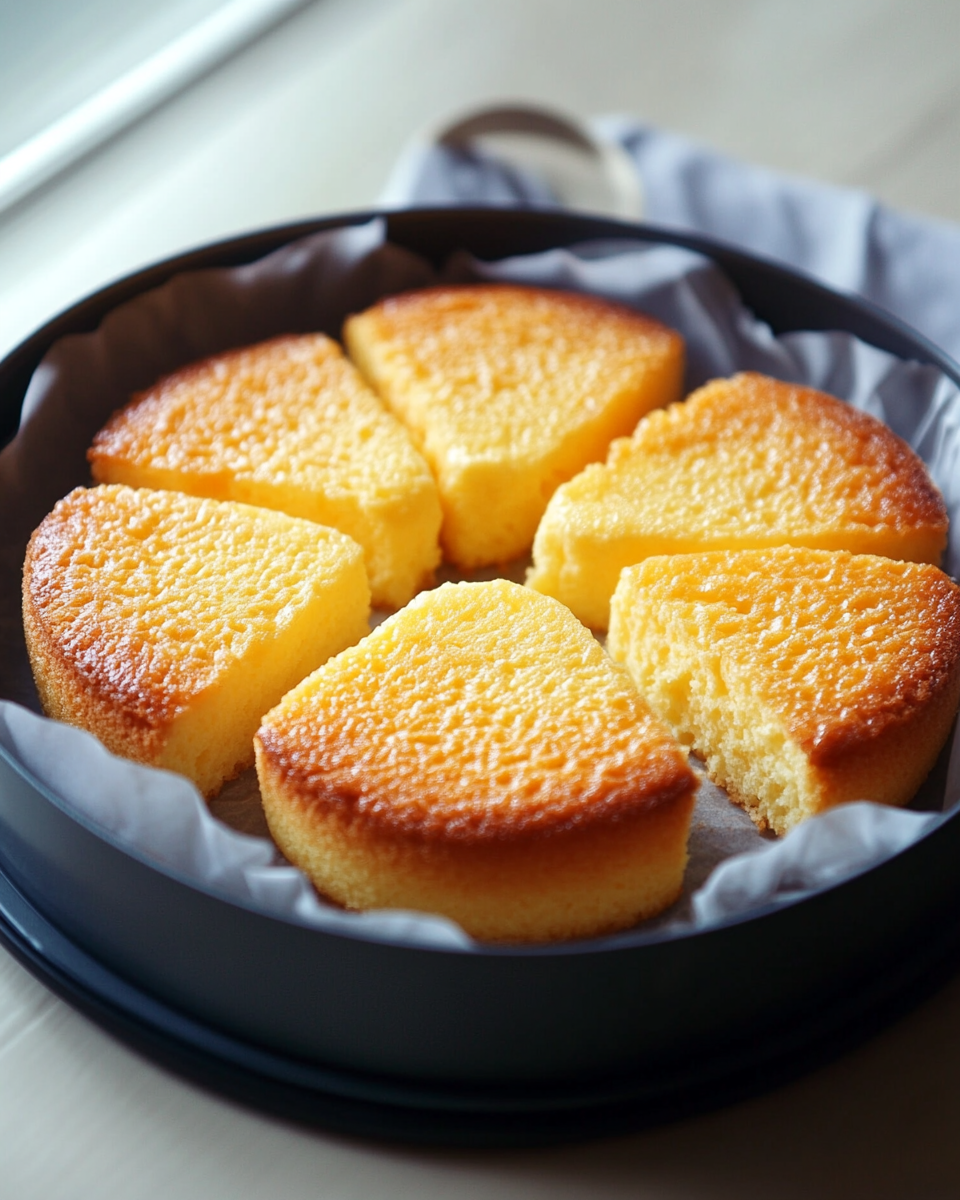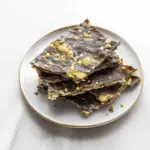The Chinese Egg Cake is a time-honored delicacy beloved for its pillowy texture and naturally sweet aroma. Traditionally steamed, this cake is known for its simple ingredients and soothing flavor profile. It’s an ideal pairing for hot tea or a light dessert after a savory meal. Reimagined here as a gluten-free treat, this version retains all the softness and integrity of the original. With no need for baking and minimal prep, this cake rises purely from the power of eggs, making it a healthier, low-fat option that doesn’t skimp on tradition or taste.
Full Recipe:
Ingredients:
-
4 large eggs
-
½ cup granulated sugar
-
1 cup gluten-free cake flour (sifted)
-
1 tablespoon milk (optional for extra moisture)
-
1 teaspoon vanilla extract (optional)
-
Parchment paper for lining
Directions:
-
Preheat your steamer by bringing water to a boil. Line a 6-inch round or square cake pan with parchment paper.
-
In a mixing bowl, beat eggs on high speed for 5–7 minutes until pale and tripled in volume.
-
Gradually add sugar while continuing to beat until fully dissolved.
-
Gently fold in sifted gluten-free cake flour using a spatula. Add milk and vanilla extract if using. Mix just until combined.
-
Pour the batter into the lined cake pan. Tap gently to remove air bubbles.
-
Place the pan into the steamer and cover with a lid wrapped in a clean towel to prevent condensation.
-
Steam over medium heat for 30–35 minutes or until a toothpick inserted in the center comes out clean.
-
Carefully remove the cake and let it cool slightly before unmolding.
-
Serve warm or at room temperature.
Prep Time: 10 minutes | Cooking Time: 35 minutes | Total Time: 45 minutes
Kcal: 145 kcal | Servings: 6 servings
Discovering the Chinese Egg Cake: A Classic Steamed Delight Made Gluten-Free
The Chinese Egg Cake, also known in Cantonese as “Gāau Dàn Gōu” (糕蛋糕), is a delicately sweet, airy sponge cake that has stood the test of time in Chinese culinary tradition. Light as a cloud and mildly sweet, it relies on eggs as the main leavening agent rather than baking powder or yeast. Often steamed instead of baked, this dessert is prized for its simplicity, texture, and nostalgic appeal.
Traditionally served as a street snack or enjoyed during tea time, the Chinese Egg Cake is a recipe passed down through generations. It evokes childhood memories for many and holds cultural significance, especially in southern parts of China and Hong Kong. By making this cake gluten-free, we’ve adapted a beloved classic for modern diets particularly for those managing celiac disease or gluten sensitivities without sacrificing taste, texture, or authenticity.
The Cultural Roots of Chinese Egg Cake
This cake has humble beginnings. It’s often associated with Hong Kong street vendors who used to whip up large batches in aluminum trays, steam them until puffed, and slice them into squares for eager customers. It’s the kind of snack that would be wrapped in parchment or newspaper and eaten on the go soft, warm, and comforting.
In a traditional Chinese household, egg cake is often served during Lunar New Year or festive family gatherings. Its golden-yellow color symbolizes wealth and prosperity. Many older generations also believe the cake embodies good fortune, which is why it’s a staple during celebratory occasions.
What sets it apart from Western sponge cakes is its low-fat content, unique steaming process, and the texture achieved purely from egg aeration. It’s a beautiful demonstration of how simple pantry staples can come together to create a satisfying and elegant treat.
Texture and Flavor Profile
At its best, the Chinese Egg Cake should be soft, moist, and feather-light. The structure is delicate and slightly bouncy to the touch, with an even crumb throughout. Unlike its Western sponge counterparts, this cake contains no butter or oil, which contributes to its ethereal texture.
Flavor-wise, the cake is understated. It carries a mild eggy richness and gentle sweetness that pairs perfectly with green or jasmine tea. Some modern variations include a splash of vanilla, almond extract, or even citrus zest, but purists will often prefer it in its most basic form letting the egg and sugar speak for themselves.
A Modern Gluten-Free Twist
Traditional Chinese Egg Cake uses cake flour, which contains gluten and poses a challenge for those with gluten intolerance. Fortunately, with a few adjustments, this cake adapts beautifully to a gluten-free version. By substituting with a gluten-free cake flour blend ideally one designed for baking and light textures we can achieve the same fluffiness and crumb without compromising dietary needs.
The key to success lies in the technique: beating the eggs until they reach a ribbon stage and folding the flour gently without deflating the air. Steaming instead of baking also helps create a moist and tender result without any crust, which is preferred for this cake style.
Why Steam Instead of Bake?
Steaming is an age-old cooking method used throughout Chinese cuisine, and it makes a lot of sense for this particular cake. Not only does it eliminate the need for an oven making it accessible to more home cooks but it also ensures a moist texture. The steam environment prevents the cake from drying out, which is particularly helpful when working with gluten-free flours that may behave differently than traditional wheat flour.
Steaming also contributes to the cake’s unique surface and bite. There’s no browning, so the appearance remains light yellow and uniform, adding to its visual appeal when sliced.
Serving Ideas and Occasions
Chinese Egg Cake is incredibly versatile. While it’s often served on its own, you can elevate it with light garnishes such as fresh fruit, powdered sugar, or a drizzle of honey. For an indulgent twist, some people serve it with whipped cream or alongside a scoop of matcha or red bean ice cream.
In terms of occasion, this cake fits beautifully in both casual and formal settings:
-
Afternoon Tea: Pair with oolong or chrysanthemum tea for a traditional Chinese experience.
-
Breakfast: A slice in the morning with some fruit and tea offers a nutritious, low-fat start to the day.
-
Celebrations: Serve on a festive platter during Chinese New Year, birthdays, or family reunions.
Its ability to be both humble and elegant makes it an excellent choice for nearly any gathering.
Common Mistakes and Tips for Success
Though the ingredient list is simple, technique is crucial. Here are a few tips to make your gluten-free Chinese Egg Cake a success:
-
Beat the eggs well: The aeration of the eggs is the backbone of this cake’s rise. Beat until the mixture is thick and pale, with a ribbon trail forming when you lift the beaters.
-
Use sifted flour: This prevents clumps and helps with even mixing.
-
Fold gently: Do not overmix or stir vigorously after adding the flour, as you’ll lose valuable air bubbles.
-
Avoid condensation: When steaming, wrap the lid with a clean kitchen towel to prevent water from dripping onto the cake’s surface.
-
Test doneness with a skewer: When inserted into the center, it should come out clean.
Variations and Regional Differences
While the base Chinese Egg Cake remains relatively standard, there are regional tweaks and modern variations worth exploring:
-
Ma Lai Go (Malay Cake): A dim sum variation made with brown sugar and often fermented with yeast. It’s richer, darker, and slightly more complex in flavor.
-
Layered Egg Cakes: Some recipes call for layering the batter and steaming in stages to create striped versions.
-
Infused Flavors: Modern spins sometimes include matcha, pandan, or even cocoa powder for a fusion twist.
These versions illustrate how adaptable the egg cake can be, especially in a multicultural kitchen.
Gluten-Free and Proud
Choosing gluten-free doesn’t have to mean sacrificing tradition. This gluten-free Chinese Egg Cake is a perfect example of how ancient recipes can be thoughtfully adapted to meet contemporary dietary needs. Whether you follow a gluten-free lifestyle out of necessity or choice, this cake offers a taste of Chinese culture in a form that’s safe and delicious for everyone.
It also opens the door for other traditional Asian bakes to be reimagined with gluten-free flours. By learning how to work with texture and steam, you can unlock a whole world of nostalgic comfort foods, sans gluten.
Conclusion:
The Chinese Egg Cake is more than just a dessert it’s a cultural artifact, a nostalgic comfort food, and now, an accessible gluten-free indulgence. Whether you’re new to Chinese cooking or a seasoned food lover looking for something light and elegant, this cake fits the bill.
Its simplicity is its strength. Few ingredients, minimal tools, and a short cooking time make it a practical choice for weekday treats or weekend experiments. And thanks to the magic of steam and careful technique, even a gluten-free version can deliver all the softness and flavor of the original.
In bringing this traditional cake into the gluten-free realm, we pay homage to generations of Chinese home cooks while inviting everyone to take part in the joy of steamed sweets. If you’ve never tried a Chinese Egg Cake before, this is the perfect recipe to start with. And if you already love it, this gluten-free version may become your new go-to.






